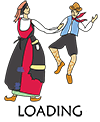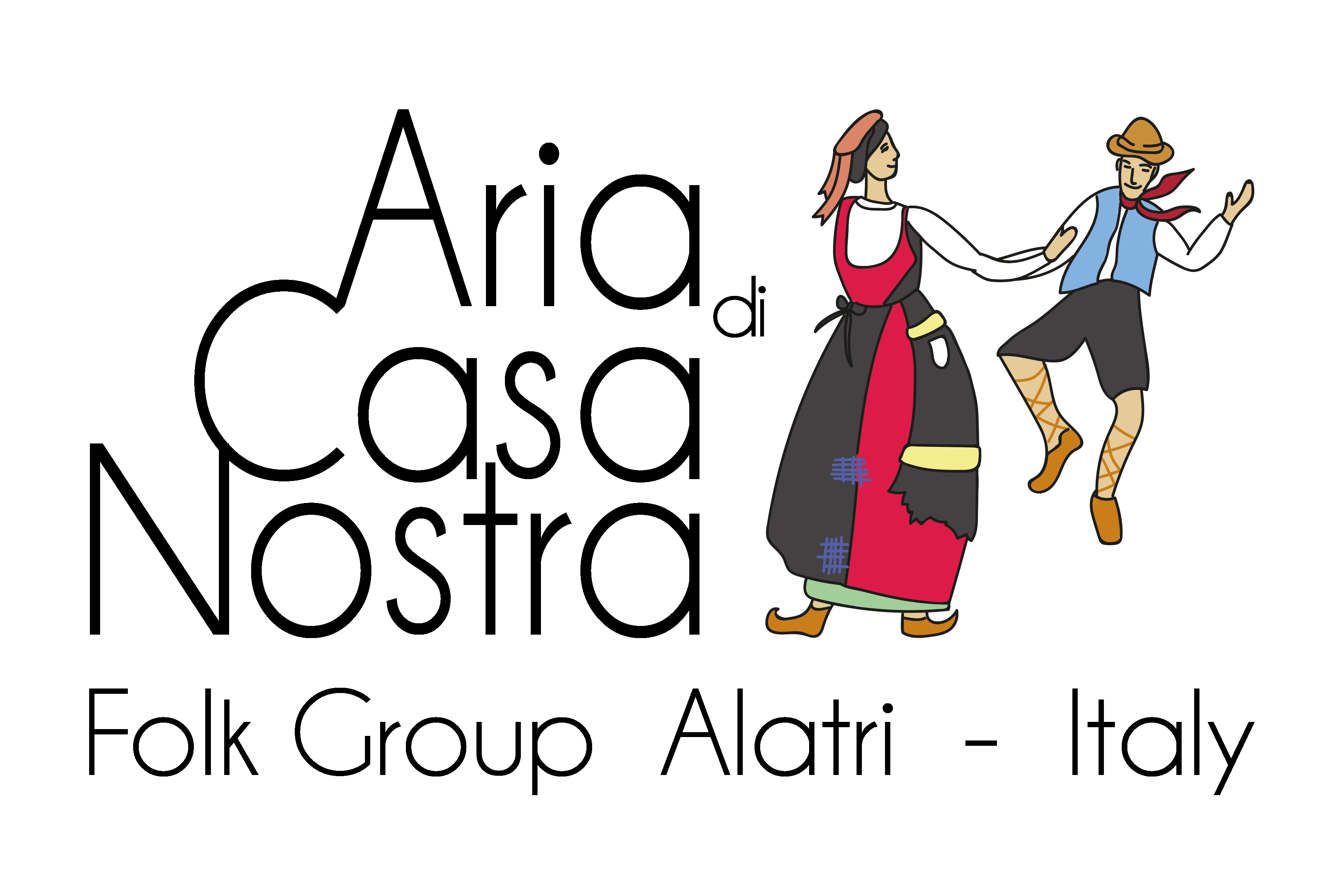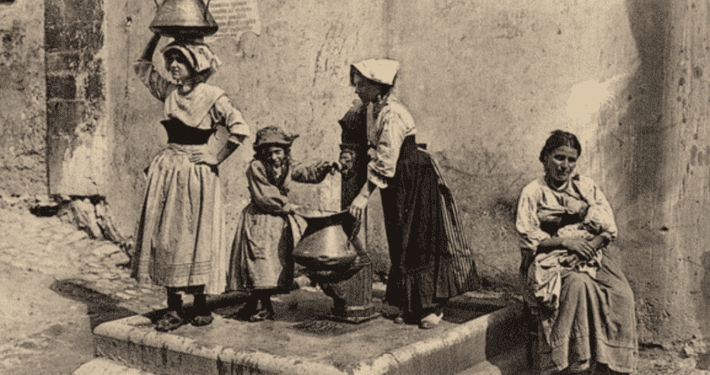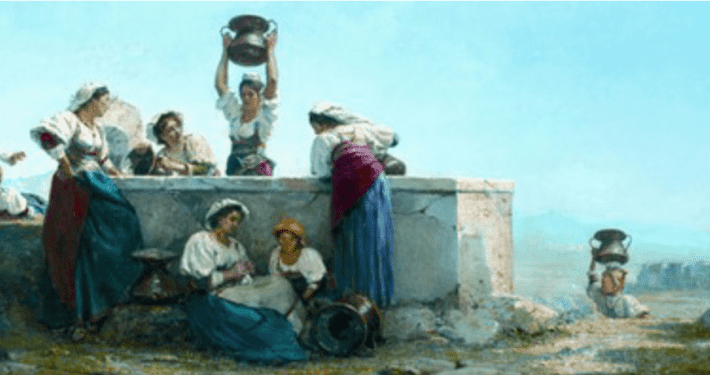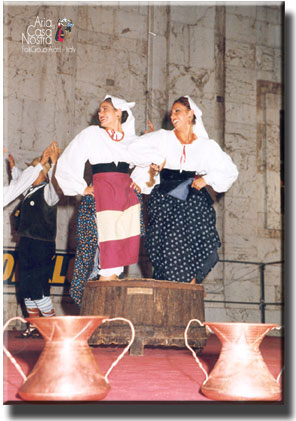CIOCIARO TRADITIONAL DRESS
Our folk group devotes a lot of care to the realization of costumes.
In fact, the dress is certainly, also for the collective imagination, a feature strongly characterizing the tradition and culture of people.
The costumes of Aria di Casa are our faithful reproductions of those of our ciociaria ancestors; for their realization the oleographs by Filippo Balbi (painter of the Neapolitan school, lived in Alatri in the second half of the nineteenth century) are an excellent help.
So let’s see the men’s and women’s dress in detail.
Woman
The “Ciociara” woman generally had two dresses; a work dress and so for every day and a dress for the holidays.
Holydays Dress:
The shirt
It was much longer than the current shirts, fulfilling the function of the current underwear. The sleeves were very large. The under-arm portion was a replaceable piece of cloth after wear, just as the lower part of the canvas was replaceable. The color of this shirt was strictly white.
The knickers
They constituted the most intimate part of the costume. They were generally long up to the knee and adorned with lace and lace typical of the woman’s individual taste and possibilities.
The socks
Long wool stockings up to the knee. They could be plain-colored or white-based with stripes of different colors.
The bodice
Made with soft cloth, often the cloth, in bright colors (red, green, blue) and closed on the front with a black lanyard.
The bust
Made almost always in black velvet, it was obviously stiff thanks to the internal support slats. It was worn over the bodice and its stiffness, between the breasts and the hips, was going to shape the figure.
The skirt
It was rich in folds in the back while it was lacking on the front. This skirt was predominantly white, adorned with a colored band * towards the final part.
* For the many women of Ciociaria who served as nurses for the well-to-do families, the color of the band that adorned the skirt was indicative of the family.
The “zinale”
Apron almost always made with the base in black interspersed with two colored strips . It was rectangular in shape and was supported by a thin tape turned several times around the waist.
The “manicotti”
Similar to the sleeves, they covered from the elbow to the wrist and were used by women to protect the party shirt in the part of the forearm.
The “mantila”
Rectangle of white canvas that covers the head. It could be differently folded and decorated according to customized variants.
The necklace (corals)
Coral necklace with a gold clasp. It could be composed of one or more wires, depending on the economic possibilities. (“The Curaglia” was usually the mother-in-law’s gift to her daughter-in-law on her wedding day.)
Earrings- “Campanacci”
The most common and certainly the most characteristic among the earrings worn by the women of Ciociare. They were long earrings in gold, often with a terminal pearl.
Everyday dress
In the costume of every day only some details change, such as:
The shirt
Mostly white, with very wide sleeves and a boat neckline with a small slit on the chest closed by a colored cord knotted in a bow. This classic model had many variations; it could have a different color, plain or fancy, with a square neckline buttoned on the front or a round or square neckline buttoned on the back.
The bust
Rigid bust with square neckline, closed behind by a long string and in front by hooks. It could be of different colors. As evidenced by Balbi’s paintings, the bust could have different characteristics such as braces or embroidery.
The skirt
It was in flowered or striped cottony on a plain background, with many small folds at the waist where it fastened with a tape. The band near the brim was reinforced entirely by a strip of fabric and highlighted by some bends.
The “zinale”
Rectangular black or blue apron, sometimes very rough, with one or two strips of plain colored or flowered fabric.
The “mantila”
Rectangle of cloth that covered the head, often adorned with lace and embroidery.
In the everyday habit it was not exclusively white, it could also be colored.
Man
The shirt
It was white for the party and checked for every day. In both cases the sleeves were very large. The white shirt was usually made of cotton, the checked shirt instead of soft fabrics and at the same time heavy as the fustian.
Trousers
They were generally dark in solid color, made of cloth or velvet and long to below the knee. The black trousers were almost always edged in red.
The socks
Like those of women, men’s socks could also be made of solid colors or stripes of different colors, predominantly dark.
The band
Strip of soft and brightly colors. It was turned several times around the waist and was meant to support the trousers.
The jacket
It was sleeveless, like a waistcoat, and was worn over his shirt. Made of brightly colored cloth or in smooth or ribbed velvet.
The masculine costume could also be completed by a hat, generally made of felt, and by a heavy fabric cloak. Both of dark color.
The “Ciocia”
Common to men and women was “the ciocia”; the famous shoes of ancient origin to which our beloved Ciociaria owes its name.
The “ciocie” consisted of a suitably treated leather sole that adapted, self-modeling, to the shape of the foot. From the sole of the corrugations (“strenghe”) that wrapped the leg up under the knee to finish, tied by a piece of string, under the knee.
The “Conca”
The bowl, copper vessel with two large handles on the sides, is another characteristic element that faithfully represents the past reality of this land. All the families possessed of it in good number and in different sizes.
Women of all ages hoisted her on the head using a cloth rolled up on itself as a support (“The croglia”) and, several times a day, to compensate for the lack of running water in the houses reached the numerous fountains of the country that became therefore a place of meeting and talk.
During the shows, the group also uses many tools of rural life: “tino” (in which the girls mimic dancing, the squeezing of the grapes after the harvest), the “canistro” the “uigli”, the “igliara”, the hoe, the cugna, the strummul’…
